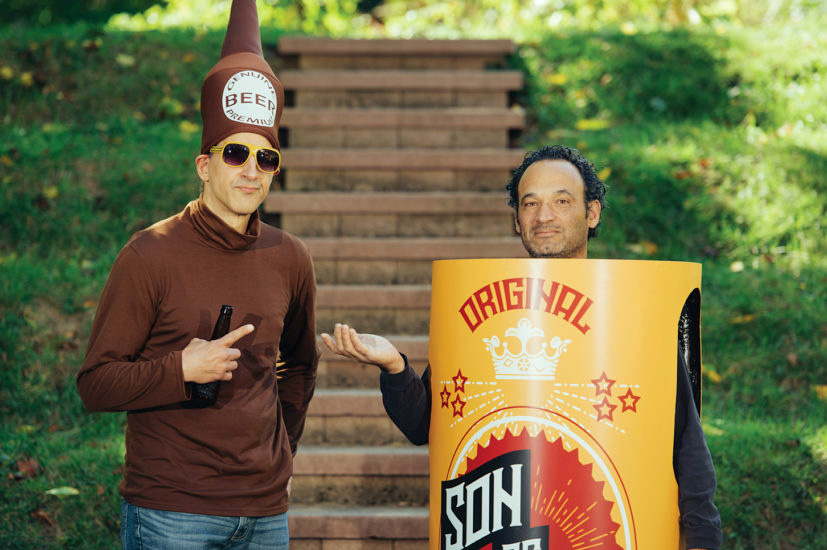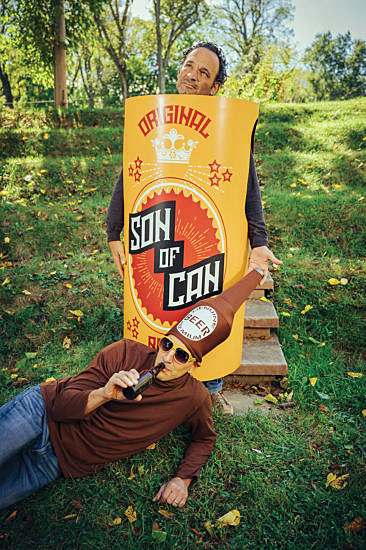
Premiering Nov. 9 at the Queen, a light-hearted, locally-produced documentary ‘studies’ this beer-based controversy
“In the beginning, I proclaimed, ‘let there be light…beer.’”
Those are the opening words of “the Creator” in Beer Can: A Love Story, a new film about humble beer cans and true love, as well as haughty beer bottles and fun.
The lighthearted documentary comes from Matthew Del Pizzo, owner of Townsend’s Del Pizzo Construction, and Gordon DelGiorno, co-founder of Film Brothers. Its world premiere will be Saturday, Nov. 9, at The Queen in Wilmington—at the conclusion, appropriately, of Wilmington Beer Week.
The four-hour event will include a showing of the 30-minute film, the release of Wilmington Brew Works’ limited-edition The Son of Can lager, can- and bottle-themed music from Shelley Kelley and Bar Flies, and some surprises. Details, including ticket information, are posted on beercanalovestory.com.
The two men, friends from Delcastle Technical High School, hope to follow the premiere with a 20-city cross-country “canPaign” inviting beer lovers to watch their film and “cask” their vote: “bottle, can or crafty independent.” They’re negotiating the details with various local breweries.
Del Pizzo and DelGiorno are the film’s producers (they covered the five-figure cost), directors (they had the artistic vision, based on Del Pizzo’s original idea) and stars (they carry the movie without a word of dialogue).
Del Pizzo plays the Can, using a nifty Son of Can costume designed by Chris Vellrath (also the film’s photographer and co-editor), with construction by Del Pizzo and wrapping by Wilmington’s Trophy Shop.
DelGiorgno plays the Bottle, using a brown turtleneck, $20 bottle-shaped headgear that he bought online, and an evocative physique (tall and long-necked).
“We’re having fun at 51,” Del Pizzo says.
An Epic Showdown
The movie follows the Can and the Bottle through funny and/or emotional encounters. It’s a simple plot that adheres to DelGiorno’s first film-making advice, from a stranger he met in a Philadelphia bar, jotted down on a napkin and saved for two decades: “Who are your characters? What’s the conflict? Who wins or fails?”
DelGiorno offers a strong hint: “It’s Bottle vs. Can. That’s the showdown.” The filmmakers make it clear the “love” in the title refers to the affection many drinkers feel for beer cans. And that means (spoiler alert) the Can wins.
“Former Gov. Pete du Pont once called Delaware’s typical voter ‘Joe Six-Pack,’” they write on the film’s Facebook page. “Wear the moniker with pride, and tell us: Are you a Bottle or a Can in that six-pack?” A now-closed poll on that page gave the edge to the can, 52 to 48 percent.
The plot is intercut with archival television commercials and interviews with brewers, a beer historian, the Beer Monk (See pg. 27), fans of beer, and Jeff Lebo, a Pennsylvania man with the world’s largest collection of vintage beer cans. “We can learn something about the human condition by looking at these things,” Lebo says about beer cans in the film.
The genesis of Beer Can was in 2018, when Del Pizzo decided to sell his collection of 4,000 beer cans. “It was a release, like Linus and his security blanket. You can’t hold onto everything,” he says, although he did hold onto two cans of 1938 Diamond State beer, Delaware’s first canned beer.
In trying to sell his collection, he met “eclectic people” who had stories to tell, which led him to suggest to DelGiorno that those stories be captured in a movie (it’s Del Pizzo’s film debut, DelGiorno’s—by his estimate—800th appearance). “We’re letting those people on the fringe of the beer world have their say,” Del Pizzo says.
A devout environmentalist who thinks green in his construction business and is a long-time Delaware Audubon Society volunteer leader, Del Pizzo also hopes the film will highlight the eco-advantages of cans.

Throughout Delaware and Beyond
With a plan—but not a formal script—the two friends shot four hours of footage over a year, including scenes at the Bottle & Cork in Dewey Beach, the Dogfish Head Brewery treehouse in Milton, Wilmington Brew Works, Stitch House Brewery in Wilmington, Chelsea Tavern in Wilmington and the West Chester Craft Beer Festival. Interviews with experts sent them further afield.
They devoted 130 hours to editing; added graphics, animation and music; returned to some locales for shots they later decided were needed; and wrote narration for Film Brothers veteran Jim Rubright as the Creator to bring it all together.
They are excited about the film and already have in mind a sequel (according to Del Pizzo) and even a trilogy (according to DelGiorno).
They’re also excited about future ventures. Del Pizzo for years supported the Film Brothers’ Festival of Shorts (on hiatus to devote time and energy to Beer Can), and after this project, DelGiorno calls Del Pizzo “a partner and a film brother now.”
The movie also marks the 20th anniversary of Film Brothers, whose first film, Franks and Wieners, also included Rubright in the cast. It was written and directed by DelGiorno and his brother Greg, now a New York-based set builder.
As expected from the biblical wording in the beginning, a religious motif recurs in Beer Can, including what its website calls “a modern resurrection” of the can as a container for beer. There also are several levels to the film, something that Del Pizzo treasures but DelGiorno feels will go over too many heads. “It’s painful to think deeply,” DelGiorno says. “I want a slow burn.”

History Lessons
Beer history goes back millennia. Beer bottles go back centuries. Beer cans date only to 1935.
Cans quickly gained popularity, but, as the film points out, they became associated with bland mass-produced brews. So when craft beers became a thing, these small brewers went for bottles as a testament to their tastiness. “The craft industry is created around the bottle,” Del Pizzo says. “But they are finally embracing the can.”
There are mostly facts on the pro side for cans. Cans don’t let in light that can skunk the beer. Cans are cheaper, lighter to transport, and they don’t break.
The con side for cans, by contrast, is not fact-based. Cans have a reputation for leaving a metallic taste, but that’s false, says Del Pizzo, who may be biased—he plays the Can in the movie. Aluminum doesn’t affect the taste; after all, a can is just a small keg. Cans have a down-market reputation. Commercials in Beer Can show a class divide from decades past: casual can-drinkers are frolicking on the beach, while snobby bottle-drinkers are sipping indoors.
Dogfish Head founder Sam Calagione says in the film that he felt at first that bottles were “an ideal package” that gave his craft beer a wine-like appeal. He stuck with bottles until sales flattened, and when he decided to go with cans, the business grew 18 percent that year, he says.
Statistically Speaking
Nationwide, cans are defeating bottles. “Cans have been growing market share for several years now,” says Lester Jones, chief economist for the National Beer Wholesalers Association. “Craft brewers have adopted the package very aggressively in recent years and made the can package a great success across many channels of retail.”
In 2018, the U.S. beer industry shipped 202.2 million barrels of beer. Currently, cans are about 57 percent of volume, with bottles at 32 percent and draft at 11 percent, Jones says.
The breakdown differs for craft beers, which represent a quarter of the American market. Bart Watson, chief economist for the Brewers Association, which represents craft brewers, says that 47 percent of craft packaged sales volume has been in cans. “A decent percentage of can production is 16-ounce cans (and we’re also seeing the 19.2-ounce format grow),” he says.
Although draft sales are 11 percent of the overall industry, they represent 40 percent of craft beer. Do the math, and it works out that about 28 percent of craft production is in cans.
Demographics suggest that can’s dominance will continue. “The millennials like cans. It’s all they want,” Carol Stoudt, the country’s first female brewmaster, says in the film. “Go figure.”
When casting the film, Del Pizzo and DelGiorno realized that they embody “the respective characteristics of the can and bottle themselves,” beercanalovestory.com says. “Matt is thoughtful, quiet, short and often misunderstood. Gordon is brash, loud, tall and maybe a little abrasive.”
Del Pizzo notes that he has an AOL email account. “That’s old, like a can,” he says. “I still play CDs. I’m not on Facebook.” DelGiorno, on the other hand? “In business, he’s a hustler, like a bottle,” Del Pizzo says.
Their personalities are also on display in their refrigerators. The evening before their interview, DelGiorno says he enjoyed two bottles from the Kona Brewing Co. and a can of Blah Blah Blah IPA from 21st Amendment Brewery. Del Pizzo’s only chilled choice: “PBR in a can. Nine of them.”

